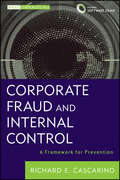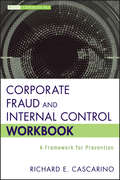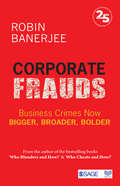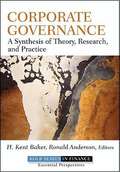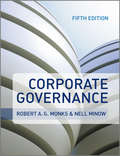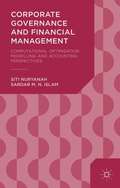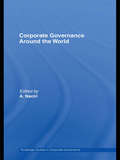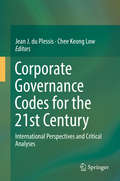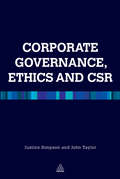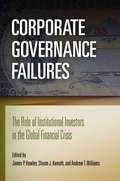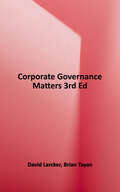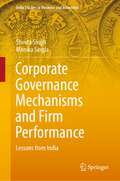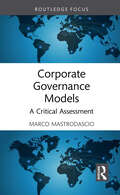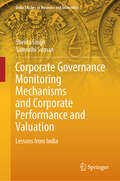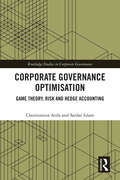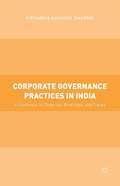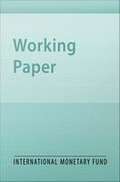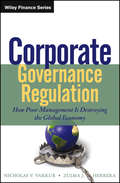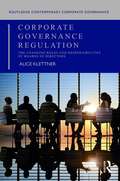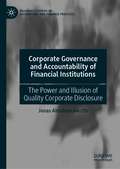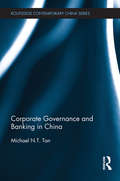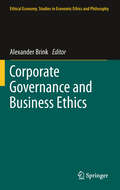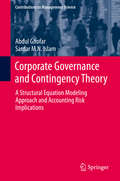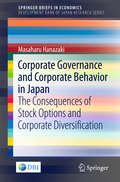- Table View
- List View
Corporate Fraud and Internal Control + Software Demo
by Richard E. CascarinoEssential guidance for companies to examine and improve their fraud programsCorporate governance legislation has become increasingly concerned with the ongoing resilience of organizations and, particularly, with their ability to resist corporate fraud from the lowest levels to the upper echelons of executive management. It has become unacceptable for those responsible for corporate governance to claim, "I didn't know." Corporate Fraud and Internal Control focuses on the appropriateness of the design of the system of internal controls in fraud risk mitigation, as well as the mechanisms to ensure effective implementation and monitoring on an ongoing basis.Applicable for a wide variety of environments, including governmental, financial, manufacturing and e-business sectorsIncludes case studies from the United States, Europe, and AfricaFollows the standards laid down by the Association of Certified Fraud Examiners, the internationally recognized body governing this activityAccompanying interrogation software demo (software demo is not included as part of this book's e-book file, but is available for download after purchase)Written by a fraud prevention leader, Corporate Fraud and Internal Control addresses the concerns of both management and audit in ensuring a demonstrable level of activity to ensure sustainability of the organization and minimization of the impacts of fraud, upon early detection.
Corporate Fraud and Internal Control Workbook
by Richard E. CascarinoThe essential companion to Corporate Fraud and Internal Control, complete with review exercises for key conceptsUsed together with Corporate Fraud and Internal Control: A Framework for Prevention, this Workbook tests readers' knowledge of the subject with a focus on the appropriateness of the design of the system of internal controls in fraud risk mitigation, as well as the mechanisms to ensure effective implementation and monitoring on an ongoing basis. This Workbook includes step-by-step exercises and tests to help the reader master the techniques in fraud prevention and detection.Companion to Corporate Fraud and Internal Control: A Framework for PreventionIncludes step-by-step exercise and testsProvides discussion-based case studiesFeatures the necessary tools that companies need to combat fraudWritten by a fraud prevention leader, Corporate Fraud and Internal Control Workbook features a fill in the blanks structure, followed by a short answer section, and ending with a discussion based series of case studies covering the following topics.
Corporate Frauds: Business Crimes now Bigger, Broader, Bolder
by Robin BanerjeeFalsification of accounting numbers, financial shenanigans, banking deceits, reneging on quality promises, money laundering, tax avoidance, shell companies, Ponzi schemes, technology tricks, insurance imposters and investors falling into the potholes of lies and damn lies—Corporate frauds are getting bigger, broader and bolder. The size and scale of business deceit is becoming murkier, messier and massive even as regulatory strictures are getting bolstered. On top of it, the coronavirus crisis brought new opportunities for the fraudsters with cybercrimes reaching unprecedented levels. Awareness of how swindlers rip off and knowing their tricks will help unravel the hocus-pocus of the magicians of hoax. This book is an attempt to bring to fore the many lies and deceptions committed by the business world. From the author for two bestsellers, Who Blunders and How (2019) and Who Cheats and How (2015), comes an exciting and pacy rundown of how cons and swindlers mint money. The book discusses the psyche and modus operandi of the defrauders. It stresses the impact and possible actions to avoid, prevent or protect against chicaneries. Read this book to be aware, anticipate and avoid the business-world charlatans lurking around to con us.
Corporate Friction: How Corporate Law Impedes American Progress And What To Do About It
by David YosifonCorporate law in the United States requires directors to manage firms in the interests of shareholders, which means never sacrificing profits in service of other stakeholders or interests. <P><P>In this timely, groundbreaking book, David Yosifon argues that this rule of 'shareholder primacy' is logically, ethically, and practically unsound, and should be replaced by a new standard that compels directors of our largest corporations to manage firms in a socially responsible way. In addition to summarizing existing debates on the issue - and giving special attention to the Supreme Court's decision in Citizens United - Yosifon explores the problem of corporate patriotism and develops a novel approach to the relationship between corporate law and consumer culture.<P> The book's technical acumen will appeal to experts, while its engaging prose will satisfy anyone interested in what our corporate law does, and what it should do better.<P> Explains how our existing corporate law causes corporations to behave in socially irresponsible ways.<P> Articulates reforms to make corporations more socially responsible.<P> Reviews and deepens sophisticated corporate law debates in a readable and pleasing prose style.
Corporate Governance
by H. Kent Baker Ronald AndersonA detailed look at the importance of corporate governance in today's business worldThe importance of corporate governance became dramatically clear at the beginning of the twenty-first century as a series of corporate meltdowns from managerial fraud, misconduct, and negligence caused a massive loss of shareholder wealth.As part of the Robert W. Kolb Series in Finance, this book provides a comprehensive view of the shareholder-manager relationship and examines the current state of governance mechanisms in mitigating the principal-agent conflict. This book also offers informed suggestions and predictions about the future direction of corporate governance.Relies on recent research findings to provide guidance through the maze of theories and conceptsUses a structured approach to put corporate governance in perspectiveAddresses essential issues related to corporate governance including the idea of principal-agent conflict, role of the board of directors, executive compensation, corporate monitoring, proxy contests and corporate takeovers, and regulatory interventionCorporate governance is an essential part of mainstream finance. If you need to gain a better understanding of this topic, look no further than this book.
Corporate Governance
by Robert A. Monks Nell MinowIn the wake of the recent global financial collapse the timely new edition of this successful text provides students and business professionals with a welcome update of the key issues facing managers, boards of directors, investors, and shareholders.In addition to its authoritative overview of the history, the myth and the reality of corporate governance, this new edition has been updated to include:analysis of the financial crisis;the reasons for the global scale of the recessionthe failure of international risk managementAn overview of corporate governance guidelines and codes of practice;new cases.Once again in the new edition of their textbook, Robert A. G. Monks and Nell Minow show clearly the role of corporate governance in making sure the right questions are asked and the necessary checks and balances in place to protect the long-term, sustainable value of the enterprise.Features 18 case studies of institutions and corporations in crisis, and analyses the reasons for their fall (Cases include Lehman Brothers, General Motors, American Express, Time Warner, IBM and Premier Oil.)
Corporate Governance And Financial Management
by Sardar M. N. Islam Siti NuryanahThis book integrates corporate governance, corporate finance and accounting to formulate sound financial management strategies. It offers practical steps for managers using an integrated optimisation financial model to achieve good corporate governance practices which lead to lower risks and higher firm value.
Corporate Governance Around the World (Routledge Studies In Corporate Governance Ser. #Vol. 1)
by Ahmed NaciriThe last Asian financial crisis, coupled with the western series of corporate scandals, has caused investors and citizens to doubt mangers ability to guarantee credible financial information about organizations. Consequently, legislators all over the world have come to realise the necessity of legislating in the area of corporate governance.
Corporate Governance Codes for the 21st Century: International Perspectives and Critical Analyses
by Jean J. du Plessis Chee Keong LowThe book is the first comprehensive consideration, since the UK Cadbury Report recommended a voluntary Corporate Governance Code, of the question whether Corporate Governance Codes are the most effective way of ensuring adherence to good corporate governance principles. There is no doubt that the idea of voluntary compliance with good corporate governance practices, based on the principle of 'comply or explain', has captured the imagination of the world. It is probably one of the best and most comprehensive examples of 'self-regulation' ever seen in any area where the society could be affected significantly, for current purposes by corporations. However, is this the most effective way of ensuring that corporations act responsibly and adhere to good corporate governance principles? Have these Codes really improved corporate governance practices significantly? Is it time for a rethink and, at least in certain areas, start to rely more on 'hard law' and clearer expectations to ensure compliance? All these issues are addressed in the book.
Corporate Governance Ethics and CSR
by John R Taylor Justine SimpsonCorporate Governance, Ethics and Corporate Social Responsibility brings together the three separate strands relevant to the new demands of organizational behaviour and reporting. Taking a holistic approach to the issue of the role of the organization in society, the responsibilities within which it operates, obligations to its stakeholders (including its employees and their dependents) and the ethical underpinning which has to be in place for any form of honest reporting, the authors look not only at the organization as a reporting entity complying with a set of rules or nebulous concepts but as a functioning part of the business environment. Offering a wealth of real-life examples and case studies, the author demonstrate the realities of balancing socially responsible business with modern business practice in a diverse range of organizations, including both the private and public sector.
Corporate Governance Failures
by James P. Hawley Shyam J. Kamath Andrew T. WilliamsCorporate governance, the internal policies and leadership that guide the actions of corporations, played a major part in the recent global financial crisis. While much blame has been targeted at compensation arrangements that rewarded extreme risk-taking but did not punish failure, the performance of large, supposedly sophisticated institutional investors in this crisis has gone for the most part unexamined. Shareholding organizations, such as pension funds and mutual funds, hold considerable sway over the financial industry from Wall Street to the City of London. Corporate Governance Failures: The Role of Institutional Investors in the Global Financial Crisis exposes the misdeeds and lapses of these institutional investors leading up to the recent economic meltdown.In this collection of original essays, edited by pioneers in the field of fiduciary capitalism, top legal and financial practitioners and researchers discuss detrimental actions and inaction of institutional investors. Corporate Governance Failures reveals how these organizations exposed themselves and their clientele to extremely complex financial instruments, such as credit default swaps, through investments in hedge and private equity funds as well as more traditional equity investments in large financial institutions. The book's contributors critique fund executives for tolerating the "pursuit of alpha" culture that led managers to pursue risky financial strategies in hopes of outperforming the market. The volume also points out how and why institutional investors failed to effectively monitor such volatile investments, ignoring relatively well-established corporate governance principles and best practices.Along with detailed investigations of institutional investor missteps, Corporate Governance Failures offers nuanced and realistic proposals to mitigate future financial pitfalls. This volume provides fresh perspectives on ways institutional investors can best act as gatekeepers and promote responsible investment.
Corporate Governance Matters: A Closer Look at Organizational Choices and Their Consequences
by David Larcker Brian TayanFully updated for the latest research, trends, and regulations, the Third Edition of this book offers comprehensive and objective information for everyone seeking to improve corporate governance--from directors to institutional investors to policymakers and researchers. To help you design highly effective governance, the authors thoroughly examine current options, reviewing what is and isn't known about their impact on organizational performance. Throughout, they take a strictly empirical and non-ideological approach that reflects rigorous statistical and research analysis and real-life examples. They address issues ranging from board structure, processes, operations, and functional responsibilities to institutional investors, outside stakeholders, and alternative forms of governance.
Corporate Governance Mechanisms and Firm Performance: Lessons from India (India Studies in Business and Economics)
by Shveta Singh Monika SinglaThis book begins by analysing the various corporate governance mechanisms explored in the extant literature and determining their effectiveness in enhancing the firm value using multivariate analysis. The findings are of global relevance as the corporate governance regulations of most countries focus on independent directors as the mainstay of good governance. The empirical evidence from the first objective of this study corroborates the claim that independent directors do not strengthen the firms’ governance quality. The book is one of the few works to have analysed the possible reasons behind the ineffectiveness of the independent directors. Also, in view of the famous concept of the bundle of governance mechanisms, it might be possible that the independent directors strengthen the firms’ governance quality indirectly by strengthening other governance mechanisms. This aspect too has little precedence. This study adopts a novel moderation and mediation approach to analyse the monitoring behaviour of independent directors in relation to other governance mechanisms. The work is a must read for corporate players as well as researchers and scholars studying this discipline.
Corporate Governance Models: A Critical Assessment (Routledge Focus on Business and Management)
by Marco MastrodascioThe activities carried out in a business organization stem from the contribution of subjects who cooperate in the expectation of obtaining adequate rewards. The ability of organizations to reach a specific level of performance is influenced by the ownership structure, while the management is directed and controlled through a set of rules and incentives. This set regulates the distribution of rights and responsibilities among the board, company management and stakeholders, and it defines the corporate governance model adopted by the organization. The collapse of global organizations across the world have undoubtedly revealed the inherent flaws in the contemporary corporate governance practices. As a result of these international scandals, a great deal of multidisciplinary research has been growing restlessly to define the specificities of each corporate governance model, however, lacking a specific investigation into the presumed existence of the most suitable one. By favouring the synthesis and the inductive procedure, this book analyses the potential existence of the most appropriate corporate governance model based on comparative international analysis of cultural, social and economic factors influencing the organization’s choice regarding the corporate governance model to be adopted. This volume will be of interest to researchers, academics, professionals, and students in the fields of corporate governance, international business, and law.
Corporate Governance Monitoring Mechanisms and Corporate Performance and Valuation: Lessons from India (India Studies in Business and Economics)
by Shveta Singh Samridhi SumanThis book delves deep into performance effects of corporate governance mechanisms. It explores how impact of board of directors, promoter owners, non-controlling large owners, and auditor independence varies according to different organizational circumstances. Examining corporate finance decisions and corporate governance practices of non-financial firms listed on NIFTY 500 index, it illustrates the main and conditional effects of corporate governance monitoring devices by checking their influence on corporate finance decisions. The book renews the business case for good corporate governance practices that go beyond a firm's valuation and profitability. It evaluates the impact of corporate governance on those corporate decisions, which have been shown to affect a firm's value. One of its most notable qualities, is its due consideration to a firm's varied organizational circumstances. As a result, the book is a useful resource toward understanding 'how' superior corporate governance mechanisms can drive a firm's value.
Corporate Governance Optimisation: Game Theory, Risk and Hedge Accounting (Routledge Studies in Corporate Governance)
by Sardar Islam Choirunnisa ArifaCorporate Governance Optimisation introduces an innovative approach to addressing some of the most pressing challenges in modern corporate governance. Combining game theory, mechanism design and hedge accounting, this research monograph offers a comprehensive framework for resolving agency conflicts, mitigating financial risks and improving organisational performance. At the heart of this book is an integrated model that unites governance, risk management and hedge accounting, demonstrating how these elements work together to address information asymmetry, incentive misalignment and decision-making complexities. Grounded in rigorous research and real-life data, the book provides practical insights into how hedge accounting can stabilise financial outcomes, support effective governance and enhance corporate value.Designed for academics, researchers and professionals in accounting, finance and corporate governance, this book bridges theory and practice, offering a robust foundation for understanding and applying advanced governance models. It is particularly valuable for those interested in how mathematical frameworks like game theory can be used to solve real-world corporate challenges. While rooted in financial optimisation, the book’s findings have broad implications for policy, strategy and risk management in diverse organisational contexts.
Corporate Governance Practices in India
by Priyanka Kaushik SharmaCorporate Governance Practices in India examines corporate governance practice in Indian industry. This book critically analyses the governance practice and evaluates the needs of corporate governance in the two major industries in India: Auto Industry and Heavy Engineering Industry. The study explores the state of compliance of the key governance parameter in both the industries in line with the mandatory and non-mandatory requirements stipulated by the Revised Clause 49 of (SEBI) ListingAgreement as also the provisions required by the Companies Act, 1956. The book aims to study the concept of corporate governance and check the level of compliance of corporate governance codes in Auto Industry and Heavy Engineering Industry in India, and draw comparisons in the adoption of corporate governance practices by Auto Industry vis-#65533;-vis Heavy Engineering Industry.
Corporate Governance Reforms in the EU: Do They Matter and How?
by Iryna Ivaschenko Petya Koeva BrooksA report from the International Monetary Fund.
Corporate Governance Regulation
by Nicholas V. Vakkur Zulma J. HerreraWhy U.S. corporate governance regulation has lost its way, and what must be done to improve itModern history persuasively demonstrates the inexorable link that binds comprehensive regulation to the global economy. This important book, rather than simply recount a litany of corporate governance failures, persuasively explains why, despite policymakers' best intentions, regulation has failed in the modern era. An objective study intended for a diverse readership, Corporate Governance Regulation unveils the underlying, root causes of regulatory failure. The result: A compelling and original analysis, broadly suited for a global audience of all backgrounds.Written by published, subject-area experts, the authors carefully delineate how U.S. corporate governance regulation, beginning with Sarbanes Oxley, lacks an adequate rational basis, as may be attributed to a non-existent policy dialogueThe witnessed result: A conspicuous lack of regulatory efficacy, enormous costs, coupled with paltry benefitsThe focus is upon reigniting a stalled, non-productive policy dialogue, by eschewing stale, overly-polemicized arguments, as needed to develop a common groundDrawing from an eclectic, analytic framework, governance experts Nicholas Vakkur and Zulma Herrera offer both the professional and global citizen alike a multi-dimensional understanding of issues critical to global economic health. Nuanced and persuasively argued, Corporate Governance Regulation represents a formidable catalyst in the elusive, ongoing quest for global economic stability.
Corporate Governance Regulation: The changing roles and responsibilities of boards of directors (Routledge Contemporary Corporate Governance)
by Alice KlettnerCorporate governance regulation has been through numerous cycles of reform, and yet we still see instances of companies collapsing suddenly. Codes of corporate governance have been implemented in most developed countries, recommending detailed governance frameworks for publicly listed companies and their boards, but our understanding of how these codes influence behaviour is still limited. In this book, Alice Klettner draws on the domains of law and business to explore the effectiveness of corporate governance codes. Using interview evidence from company directors and officers, as well as published evidence of companies’ corporate governance systems, she discusses the theory and practice of corporate governance and its regulation – with a focus on how corporate governance codes can affect board behaviour and company performance. This interdisciplinary book will be valuable reading for advanced students and researchers of corporate governance, and will also be directly relevant to governance practitioners and policymakers.
Corporate Governance and Accountability of Financial Institutions: The Power and Illusion of Quality Corporate Disclosure (Palgrave Studies in Accounting and Finance Practice)
by Jonas Abraham AkuffoThe presence of sound corporate governance in a financial institution is important in maintaining the confidence of both the market and the public. The power that corporate governance holds over the success of some of the largest financial institutions in the world is not to be downplayed. This book methodically assesses the quality of corporate governance and mechanisms of accountability disclosures to various stakeholders. It is further intended to provide fresh insights into some specific corporate governance recommendations to help improve good governance in financial institutions, particularly in the United Kingdom and the EU but will also be applicable to other major economies. It explores what, when and how corporate governance has changed the financial institution functions and corporate executive behaviour by critically reviewing the pre- and post-financial crisis theoretical and empirical literature. Increasingly driven by the nature of complications, complexities and opacity in the operations of financial systems, corporate governance reporting plays an important role in the financial sector. It will provide insights into corporate governance disclosures over a long-term basis. This book should be a valuable asset to support the research of practitioners, students and all academics due to its stimulating and reflective insights into this fascinating topic.
Corporate Governance and Banking in China (Routledge Contemporary China Series)
by Michael TanAs China began its economic reforms in the late 1970s and made a transition from planned to a market economy, corporate governance of the banking sector became an increasingly pressing issue. Further, in the aftermath of the Asian Financial Crises in the late 1990s, Chinese authorities became acutely aware of the importance of corporate governance to ensure that their banking system would not suffer similar fates to those of other Asian countries. This book examines corporate governance in city commercial banks, which are the main source of loans to the dynamic small and medium enterprises that are crucial to the development of China’s economy. By the end of 2008, there were 136 city commercial banks in China, 13 of which had foreign partners, and this book clearly demonstrates the positive effect of these foreign partnerships on corporate governance practices, in addition to financial performance. With evidence from extensive interviews with 10 city commercial banks in China, Michael Tan explores the different models of corporate governance, and in turn, asks which model is most suitable to China, how are Chinese authorities overcoming problems with corporate governance, and how do these problems compare with those in other transition economies? Whilst the primary focus of this study is on China's city commercial banks, there are lessons that apply much more broadly to the industry and it therefore will be invaluable to foreign banking institutions wishing to invest in China. This book will also be of great appeal to students and scholars of Chinese business and economics, corporate governance and banking.
Corporate Governance and Business Ethics (Ethical Economy #39)
by Alexander BrinkThis volume explores corporate governance from three perspectives: a traditional economic, a philosophical, and an integrated business ethics perspective. Corporate governance has enjoyed a long tradition in the English-speaking world of management sciences. Following its traditional understanding it is defined as leadership and control of a firm with the aim of securing the long-term survival and viability of that firm. But recent business scandals and financial crises continue to provide ample cause for concern and have all fuelled interest in the ethical aspects. As a result, corporate governance has been criticized by many social groups. Economic sciences have failed to provide a clear definition of the corporate governance concept. Complexity increases if we embed the economic approach of corporate governance in a philosophical context. This book seeks to define the concept by examining its economic, philosophical and business ethics foundations.
Corporate Governance and Contingency Theory: A Structural Equation Modeling Approach and Accounting Risk Implications (Contributions to Management Science)
by Abdul Ghofar Sardar M. N. IslamThis book analyzes the determinants and effectiveness of corporate governance in an integrated model drawing on contingency theory and employing structural equation modeling (SEM). Business competition as an environmental factor and strategy as an organizational factor are important determinants of corporate governance, while organizational performance and earnings quality are two dimensions of its effectiveness. This book focuses on the relationship between corporate governance and earnings management, and shows that corporate governance is effective in improving earnings quality and reducing accounting and governance risks. The authors also question the relation between corporate governance and company performance and present results of their analysis in this book.
Corporate Governance and Corporate Behavior in Japan: The Consequences of Stock Options and Corporate Diversification (SpringerBriefs in Economics #0)
by Masaharu HanazakiThis book carefully examines the effects of changes in the corporate governance structure on corporate behavior or company performance, using micro-data from listed companies in Japan. The author found that in Japan the introduction of stock options had neither a positive impact on profitability nor the negative side effects of promoting risk-taking behaviors. Furthermore, he found that corporate diversification and division of corporations showed negative impacts on profitability. The corporate governance structure of Japan has exhibited a large change from the second half of the 1990s to the present. There have been institutional reforms involving enterprise law, such as the introduction of stock options and the removal of the ban on holding companies. With respect to the ownership structure of a company, discernible trends are that the equity holdings of financial institutions and business corporations have fallen while the presence of foreign stockholders has risen. These trends are often pointed out as signs that the Japanese corporate governance structure has been approaching the American model and that this will energize Japanese firms. The author contradicts common academic theories, however, and concludes that the formation of the corporate governance which emphasizes the agency problem between shareholders and corporate managers is inadequate. He suggests that an institutional arrangement for a corporate governance system that values a variety of stakeholders' interests is greatly needed and concludes that perspectives on maximizing surplus values for various stakeholders and distributing the surpluses appropriately among the stakeholders will become increasingly important for the purpose of managing corporations.
